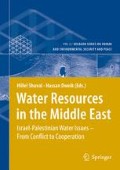Abstract
Access to sufficient volumes of water of appropriate quality is a vital human need, as demonstrated by proposals of the World Health Organization (and others). Indeed, the United Nations Committee on Economic, Social and Cultural Rights has recently recognized the human right to water. Many authors have documented the inequitable distribution of water resources in Israel and Palestine, and this issue is included as an element of the Permanent Status negotiations between both Parties. Surprisingly, the Road Map produced by the Quartet does not specifically mention the need for attention to water resources except in the context of multilateral efforts (addressing regional sources of water, and the Jordan River basin in particular). However, it is clear that the current inequitable division of the water resources as a whole in the region must be addressed if Palestine is to become an independent viable State in the future, which is a pre-condition at the end of the second phase of the Road Map.
In this and other facets of the negotiations between the Parties, Palestine should rely upon the principles of customary international law, if a robust and lasting agreement is to be attained. Israel’s reliance to date on the single criterion relating to the prior use of water should be considered against the background of the multiple factors determining the equitable and reasonable allocation of international watercourses, as set out in customary international water law. The relevance of such international law to the permanent status negotiations is discussed, and the implications for resource allocations from shared freshwater sources are addressed. It is noted that both parties will benefit significantly from the joint management of shared watercourses in the future, and a framework for this is proposed.
Access this chapter
Tax calculation will be finalised at checkout
Purchases are for personal use only
Preview
Unable to display preview. Download preview PDF.
References
Falkenmark, M.; Widstrand, C., 1992: Population and water resources: A delicate balance. Population Bulletin 47(3). (Washington, D.C.: Population Reference Bureau).
Guissé, E-H., 2004: Final Report of the Special Rapporteur. Commission on Human Rights, Sub-Commission on the Promotion and Protection of Human Rights, Fifty-sixth session; Doc. E/CN.4/Sub.2/2004/20 (New York: United Nations).
Howard, G.; Bartram, J., 2003: Domestic Water Quantity, Service, Level and Health. WHO/SDE/WSH/03/02 (Geneva: World Health Organization).
Lawrence, P.; Meigh, J.; Sullivan, C., 2002: The Water Poverty Index: An International Comparison. Economics Research Papers 2002/19 (Keele: Keele University).
Peterson, S., 2000: “Turkey’s plan for Mideast peace”, in: Christian Science Monitor, 18 April.
Shamir, U., 2004: “Testimony”, in: U.S. Congress, House, Committee on International Relations, Hearings on “Water Scarcity in the Middle East: Regional Cooperation as a Mechanism towards Peace” (Washington, D.C.: GPO, 5 May).
Shuval, H., 1992: “Approaches to resolving the water conflicts between Israel and her neighbors-a Regional Water for Peace Plan”, in: Water International, 17,2: 133–143.
Shuval, H., 2000: “A proposal for an equitable resolution to the conflicts between the Israelis and the Palestinians over the shared water resources of the Mountain Aquifer”, in: Arab Studies Quarterly, 22,2: 33–62.
United Nations, General Assembly, 1981: A/36/260/Add. 1, 25 September 1981: Thirty sixth session, Agenda item 69 (k); response by Israel of 25 March 1981; paragraph 41.
United Nations, 1992: Water Resources of the Occupied Palestinian Territory (New York: United Nations).
United Nations, 2002: General Comment No 15 of the Committee on Economic, Social and Cultural Rights entitled: The right to water (arts. 11 and 12 of the International Covenant on Economic, Social and Cultural Rights). UN Document E/C.12/2002/11 (New York: United Nations, 26 November).
WHO, 2003: The Right to Water (Geneva: World Health Organization).
Author information
Authors and Affiliations
Editor information
Editors and Affiliations
Rights and permissions
Copyright information
© 2007 Springer-Verlag Berlin Heidelberg
About this chapter
Cite this chapter
Phillips, D.J.H., Attili, S., McCaffrey, S., Murray, J.S. (2007). Factors Relating to the Equitable Distribution of Water in Israel and Palestine. In: Shuval, H., Dweik, H. (eds) Water Resources in the Middle East., vol 2. Springer, Berlin, Heidelberg. https://doi.org/10.1007/978-3-540-69509-7_25
Download citation
DOI: https://doi.org/10.1007/978-3-540-69509-7_25
Publisher Name: Springer, Berlin, Heidelberg
Print ISBN: 978-3-540-69508-0
Online ISBN: 978-3-540-69509-7
eBook Packages: Earth and Environmental ScienceEarth and Environmental Science (R0)

